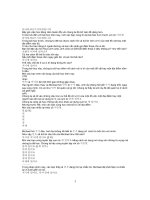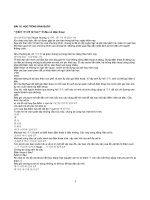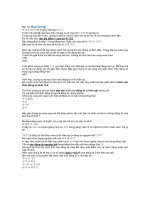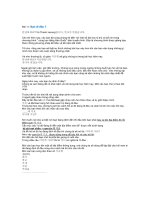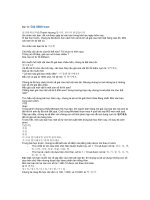Tài liệu hướng dẫn học tiếng Trung
Bạn đang xem bản rút gọn của tài liệu. Xem và tải ngay bản đầy đủ của tài liệu tại đây (252.38 KB, 47 trang )
1.01 Example sentences with temporary states
我很忙。
Wǒ hěn máng.
I'm very busy.
李雪很饿。
Lǐ Xuě hěn è.
Li Xue is very hungry.
孩子们很困。
Háizǐmen hěn kùn.
The children are very sleepy.
他很兴奋。
Tā hěn xīngfèn.
He is very excited.
我同屋很累。
Wǒ tóngwū hěn lèi.
My roommate is very tired.
>> Listen to the MP3 (right click to save)
21.02 Adjectives describing appearance
高
Gāo
Tall
矮
Ǎi
Short
瘦
Shòu
Thin
胖
Pàng
Fat
漂亮
Piàoliɑng
Pretty
帅
Shuài
Handsome
强壮
Qiángzhuàng
Strong
丑
Chǒu
Ugly
大
Dà
Big
小
Xiǎo
Small
>> Listen to the MP3 (right click to save)
21.03 Physical characteristics - Example sentences
你学校很大。
Nǐ xuéxiào hěn dà.
Your school is very big.
她哥哥很高。
Tā gēge hěn gāo.
Her older brother is very tall.
他妈妈很矮。
Tā māma hěn ǎi.
His mother is very short.
你弟弟很瘦。
Nǐ dìdi hěn shòu.
Your little brother is very thin.
我妹妹很漂亮。
Wǒ mèimei hěn piàoliɑng.
My little sister is very pretty.
她男朋友很帅。
Tā nánpéngyou hěn shuài.
Her boyfriend is very handsome.
>> Listen to the MP3 (right click to save)
21.04 Family description
我妈妈很矮,很瘦。我爸爸很胖,很强壮。我也有一个姐姐。她很漂亮。
Wǒ māma hěn ǎi,hěn shòu. Wǒ bàbɑ hěn pàng, hěn qiángzhuàng. Wǒ yě yǒu yígè mèimei. Tā
hěn piàoliɑng.
1
21.05 Negation of predicate adjectives
他不帅。
Tā bú shuài.
He isn't handsome.
李雪不高。
Lǐ Xuě bù gāo.
Li Xue is not tall.
她不瘦。
Tā bú shòu.
She isn't thin.
王军不胖。
Wáng Jūn bú pàng.
Wang Jun is not fat.
张老师不矮。
Zhāng lǎoshī bù ǎi.
Teacher Zhang is not short.
Notes:
Predicate adjectives are always negated with 不 bú, which always precedes the predicate
adjective. You can not use 没 méi to negate a predicate adjective.
21.06 Hair description vocabulary
头发
Tóufa
Hair
长
Cháng
Long
短
Duǎn
Short
卷
Juǎn
Curly
直
Zhí
Straight
>> Listen to the MP3 (right click to save)
21.07 His hair is very short. - Example sentences
他的头发很短。
Tā de tóufa hěn duǎn.
His hair is very short.
他女友的头发很长。
Tā nǚyǒu de tóufa hěn cháng.
His girlfriend's hair is very long.
萨拉的头发很卷。
Sàlā de tóufa hěn juǎn.
Sarah's hair is very curly.
李雪的头发很直。
Lǐ Xuě de tóufa hěn zhí.
Li Xue's hair is very straight.
A Transcribe the characters below into pinyin
1.) 漂亮 _____________________ 2.) 瘦 ____________________
3.) 胖 _____________________
4.) 头发 ____________________
5.) 强壮 __________________ 6.) 帅 ___________________
B Match the words with the translation
1.) Cháng Curly
2.) Ǎi
Long
3.) Juǎn Only son
4.) Chǒu
Short
2
5.) Zhí
Ugly
6.) Dúshēngzǐ
Straight
C Transcribe the following sentences into pinyin
1.) 他妹妹很漂亮。
_______________________________________________________.
2.) 我女友的头发很长。
_______________________________________________________.
3.) 你哥哥很瘦。
_______________________________________________________.
4.) 孩子们很困。
_______________________________________________________.
D Circle the character that matches the pinyin
dú :
姓 瘦 独 北
qiáng :
青 强 人 师
tóu :
国 头 瘦 直
shòu :
瘦 头 叫 京
jiě :
姐 独 北 英
dì :
名 商 头 弟
E Circle the two characters that are not the same
胖 强 矮 师
韩 商 丑 美
商 韩 师 美
胖 强 矮 高
F Translate the following pinyin into English
1.) Lǐ Xuě hěn shòu.
_______________________________________________________.
2.) Zhāng lǎoshī bù ǎi.
_______________________________________________________.
3.) Wǒ bàbɑ hěn pàng, hěn qiángzhuàng.
_______________________________________________________.
4.) Nǐ dìdi de tóufa hěn cháng.
_______________________________________________________.
G Make words by matching the two characters, then match them to the correct pinyin
介
发
piàoliɑng
职
亮
qiángzhuàng
强 员 tóufa
漂
绍
zhíyuán
头
壮
jièshào
H Circle the pinyin for the character
短 :
fāng xiōng jiàn
duǎn
漂 :
jiě piào míng běi
3
帅 :
xiān fāng shuài
piào
丑 :
yǒu chǒu shuài fāng
直 :
zhí diǎn shén
chǒu
壮 :
zhí duǎn fāng zhuàng
I Fill in the blanks with the most appropriate choice
点
Diǎn
头发
Tóufa
有
Yǒu
卷
Juǎn
父母
Fùmǔ
1.) 她男朋友的 __________ 很短。
2.) 他女友的头发很 __________ 。
3.) 我有 __________ 渴。
4.) 他 __________ 是工人。
5.) 你 __________ 男朋友吗?
22.01 Printed Materials
书
Shū
Book
杂志
Zázhì
Magazine
报纸
Bàozhǐ
Newspaper
画报
Huàbào
Pictorial
课本
Kèběn
Textbook
词典
Cídiǎn
Dictionary
小说
Xiǎoshuō
Novel
地图
Dìtú
Map
>> Listen to the MP3 (right click to save)
22.02 This and that - Example sentences
这是书,那是词典。
Zhè shì shū, nà shì cídiǎn.
This is a book, that is a dictionary.
这是报纸,那是杂志。
Zhè shì bàozhǐ, nà shì zázhì.
This is a newspaper, that is a magazine.
这是地图,那是报纸。
Zhè shì dìtú, nà shì bàozhǐ.
This is a map, that is a newspaper.
这是课本,那是小说。
Zhè shì kèběn, nà shì xiǎoshuō.
This is a textbook, that is a novel.
这是词典, 那是课本。
Zhè shì cídiǎn, nà shì kèběn.
This is a dictionary, that is a textbook.
>> Listen to the MP3 (right click to save)
Notes:
这 zhè and 那 nà are demonstrative pronouns, which means that they point out where something
is. 这 zhè means this and 那 nà means that.
Pronunciation point:
You should be careful not to confuse 那 nà with the interrogative pronoun 哪 nǎ. 那 nà has a
fourth tone falling sound, which sounds commanding or even angry to English speakers. nǎ has
the falling and then rising third tone, which to English speakers sounds a bit like someone who is
mildly incredulous of something.
4
22.03 Whose textbook is this? - Example sentences
那是谁的杂志?
Nà shì shéi de zázhì?
Whose magazine is that?
这是谁的课本?
Zhè shì shéi de kèběn?
Whose textbook is this?
那是谁的报纸?
Nà shì shéi de bàozhǐ?
Whose newspaper is that?
这是谁的词典?
Zhè shì shéi de cídiǎn?
Whose dictionary is this?
这是谁的画报?
Zhè shì shéi de huàbào?
Whose pictorial is this?
>> Listen to the MP3 (right click to save)
Notes:
The structural particle 的 de is usually put between the interrogative pronoun 谁 shéi and the
noun it is an attributive of.
22.04 It's the teacher's book
萨拉:
这是什么?
Zhè shì shénme?
王军:
这是书。
Zhè shì shū.
萨拉:
这是谁的书?
Zhè shì shéi de shū?
王军:
这是老师的书。
Zhè shì lǎoshī de shū.
22.05 This is my roommate's magazine - Concept review dialogue
马特:
那是什么?
Nà shì shénme?
李雪:
那是杂志。
Nà shì zázhì.
马特:
那是谁的杂志?
Nà shì shéi de zázhì?
李雪:
那是我同屋的杂志。
Nà shì wǒ tóngwū de zázhì.
22.06 Which magazine is yours? - Example sentences
哪本杂志是你的?
Nǎ běn zázhì shì nǐ de?
Which magazine is yours?
哪本小说是他的?
Nǎ běn xiǎoshuō shì tā de?
Which novel is his?
哪本词典是她的?
Nǎ běn cídiǎn shì tā de?
Which dictionary is hers?
哪本书是王军的?
Which book is Wang Jun's?
5
Nǎ běn shū shì Wáng Jūn de?
哪张地图是我的?
Nǎ zhāng dìtú shì wǒ de?
Which map is mine?
22.07 Sentences with possessive pronouns
这本书是我的。
Zhè běn shū shì wǒ de.
This book is mine.
那本课本是我同屋的。
Nà běn kèběn shì wǒ tóngwū de.
That textbook is my roommate's.
这本杂志是他的。
Zhè běn zázhì shì tā de.
This magazine is his.
那份报纸是张老师的。
Nà fèn bàozhǐ shì Zhāng Lǎoshī de.
That newspaper is Zhang teacher's.
Pronunciation point:
这 Zhè and 那 nà is the pronunciation you typically find in textbooks, but sometimes they may
be pronounced as zhèi and nèi, respectively. This pronunciation is only used when the words are
specifying which is which, as in "Which book out of all of these are Anna's? - This one."
Zhèi and nèi is considered to be less standard pronunciation, so there's no reason to worry about
it too muc 去 h. If you are living in China and in a region where zhèi and nèi are being used you
will probably pick them up instinctually, the way one picks up slang. Otherwise, you can never
go wrong saying Zhè and nà.
22.08 Is this your dictionary?
李雪:
那本词典是不是你的?
Nà běn cídiǎn shì bú shì nǐ de?
萨拉:
那本词典是我的。
Nà běn cídiǎn shì wǒ de.
李雪:
这本词典是不是我的?
Zhè běn cídiǎn shì bú shì wǒ de?
萨拉:
这本词典是你的。
Zhè běn cídiǎn shì nǐ de.
22.09 The Horrors of Pronunciation
直
Zhí
Straight
纸
Zhǐ
Paper
志
Zhì
Sign
A Transcribe the characters below into pinyin
1.) 杂志 _____________________ 2.) 课本 ____________________
3.) 画报 _____________________
4.) 词典 ____________________
5.) 地图 __________________ 6.) 小说 ___________________
B Translate the pinyin into English
1.) Qiángzhuàng __________________ 2.) Cídiǎn ______________
3.) Bàozhǐ _________________
4.) Piàoliɑng ________________
5.) Xiǎoshuō _________________ 6.) Dìtú ________________
C Match the words with the translation
1.) 头发 Novel
6
2.) 小说
Magazine
3.) 报纸 Strong
4.) 漂亮
Hair
5.) 强壮
Pretty
6.) 杂志
Newspaper
D Transcribe the following sentences into pinyin
1.) 那本词典是不是你的?
_______________________________________________________.
2.) 这本杂志是我的。
_______________________________________________________.
3.) 哪本小说是他的?
_______________________________________________________.
4.) 哪张地图是他的?
_______________________________________________________.
5.) 这是地图,那是报纸。
_______________________________________________________.
E Circle the character that matches the pinyin
tú :
纸 瘦 独 图
diǎn :
青 典 直 师
bào :
报 纸 瘦 直
zá :
瘦 词 纸 杂
dì :
地 独 志 纸
cí :
词 商 志 弟
F Translate the following pinyin into English
1.) Zhè shì shū, nà shì cídiǎn.
_______________________________________________________.
2.) Nà běn kèběn shì wǒ tóngwū de.
_______________________________________________________.
3.) Nǎ běn zázhì shì nǐ de?
_______________________________________________________.
4.) Zhè shì shéi de shū?
_______________________________________________________.
5.) Zhè shì bàozhǐ, nà shì zázhì.
_______________________________________________________.
G Fill in the blanks
马特: Nà shì ________?
李雪:
_____ shì _______ .
马特:
Nà shì ______ de zázhì?
李雪:
Nà _____ wǒ tóngwū de ________ .
H Arrange the words into sentences
1.) zázhì shì Zhè běn de tā .
_______________________________________________________.
7
2.) tóngwū shì bàozhǐ fèn wǒ Nà de .
_______________________________________________________.
3.) wǒ péngyou shū shì de Nà .
_______________________________________________________.
4.) shéi de Nà shì zázhì ?
_______________________________________________________.
I Write questions for the following answers
1.) _______________________________________________________?
这本书是他的。 Zhè běn shū shì tā de.
2.) _______________________________________________________?
那是报纸。 Nà shì bàozhǐ.
3.) _______________________________________________________?
这是我同屋的小说。 Zhè shì wǒ tóngwū de xiǎoshuō.
4.) _______________________________________________________?
这是画报。 Zhè shì huàbào.
23.01 What kind of book is this?
大卫:
这是什么?
Zhè shì shénme?
小张:
这是书。
Zhè shì shū.
大卫:
这是什么书?
Zhè shì shénme shū?
小张:
这是英语书。
Zhè shì Yīngyǔ shū.
大卫:
这是谁的书?
Zhè shì shéi de shū?
小张:
这是我的书。
Zhè shì wǒ de shū.
23.02 What kind of magazine is this?
马特:
这是什么?
Zhè shì shénme?
萨拉:
这是杂志。
Zhè shì zázhì.
马特:
这是什么杂志?
Zhè shì shénme zázhì?
萨拉:
这是学生杂志。
Zhè shì xuésheng zázhì.
马特:
这是谁的杂志?
Zhè shì shéi de zázhì?
陈大同:
这是李雪的杂志。
Zhè shì Lǐ Xuě de zázhì.
23.03 What's its Chinese title?
陈大同:
安娜 ,这是谁的书?是你的书吗?
8
Ānnà, zhè shì shéi de shū? Shì nǐ de shū ma?
安娜:
不是我的啊,是我朋友的。
Bú shì wǒ de a, shì wǒ péngyou de.
陈大同:
这是什么书?
Zhè shì shénme shū?
安娜:
哦,一本小说。
Ò, yì běn xiǎoshuō.
陈大同:
真的吗?那它的中文名字是什么?
Zhēn de ma? Nà tā de Zhōngwén míngzi shì shénme?
安娜:
我不知道。
Wǒ bù zhīdào.
23.04
莎拉:
这是谁的书?
Zhè shì shéi de shū?
马特:
我同屋的。
Wǒ tóngwū de.
莎拉:
那本呢?
Nà běn ne?
马特:
是我的。
Shì wǒ de.
23.05 Whose book bag is this?
李雪:
这是谁的书包?
Zhè shì shéi de shūbāo?
王军:
我的。
Wǒ de.
李雪:
那个呢?
Nà ge ne?
王军:
我室友的。
Wǒ shìyǒu de.
Notes:
The head noun can be left out if it is understood what is being referred to, this is a form of
ellipsis. It is understood in the question 那个呢? Nà ge ne? the 那个 Nà ge refers to 那个书包
Nà ge shūbāo, so there is no need to restate the noun for a second time.
Vocabulary point:
书包 shūbāo means bookbag. The word is made exactly the same as in English, by joining the
word 书 shū book to 包 bāo bag.
23.06 What kind of map is this?
萨拉:
马特,这是你的本子吗?
Mǎtè,zhè shì nǐ de běnzi ma?
马特:
是。
Shì.
9
萨拉:
这是你的地图吗?
Zhè shì nǐ de dìtú ma?
马特:
不是,这是王军的地图。
Bú shì, zhè shì Wáng Jūn de dìtú.
萨拉:
这是什么地图?
Zhè shì shénme dìtú?
王军:
这是上海市地图。
Zhè shì Shànghǎi shì dìtú.
Vocabulary point:
上海市 Shànghǎi shì means Shanghai City.
23.07 Review
大卫:
你有词典吗?
Nǐ yǒu cídiǎn ma?
小张:
我没有词典。
Wǒ méi yǒu cídiǎn.
大卫:
那这本词典是谁的?
Nà zhè běn cídiǎn shì shéi de?
小张:
我不知道。
Wǒ bù zhīdào.
A Match the words with the translation
1.) Cídiǎn Magazine
2.) Shuài
Dictionary
3.) Zázhì Thin
4.) Kèběn
Fat
5.) Shòu
Map
6.) Pàng
Handsome
7.) Dìtú
Textbook
B Match the characters with the pinyin
1.) 报纸 Shūbāo
2.) 本子
Xiǎoshuō
3.) 同屋
Dìtú
4.) 书包
Bàozhǐ
5.) 地图
Běnzi
6.) 小说
Tóngwū
10
C Transcribe the following sentences into pinyin
1.) 这是什么地图?
_______________________________________________________.
2.) 那这本词典是谁的?
_______________________________________________________.
3.) 这是什么杂志?
_______________________________________________________.
4.) 这是你的本子吗?
_______________________________________________________.
D Translate the following pinyin into English
1.) Zhè shì shénme shū?
_______________________________________________________.
2.) Wǒ méi yǒu cídiǎn.
_______________________________________________________.
3.) Zhè shì Shànghǎi shì dìtú.
_______________________________________________________.
4.) Zhè shì shéi de zázhì?
_______________________________________________________.
E Circle the pinyin for the character
地 :
pàng dì zhī diǎn
画 :
huà xiǎo shén tóng
包 :
zhè bāo běn zhǐ
本 :
cí wū běn tú
词 : dì yǒu shū cí
友 :
bāo yǒu huà cí
F Fill in the blanks with the appropriate word
大卫:
Nǐ yǒu __________ ma?
小张:
_______ méi _________ cídiǎn.
大卫:
Nà _______ běn cídiǎn shì _________ de?
小张:
Wǒ bù _________ .
G Fill in the blanks with the appropriate word
萨拉:
Mǎtè,zhè _____ nǐ de běnzi ma?
马特: Shì.
萨拉: Zhè shì ______ de _______ ma?
马特: Bú _______ , zhè shì Wáng Jūn _______ dìtú.
萨拉: Zhè shì ________ dìtú?
王军:
Zhè shì Shànghǎi shì _______.
H Circle the character that matches the pinyin
zhì :
地 图 杂 志
kè :
杂 志 课 图
shū :
图 书 叫 好
yǔ :
语 课 杂 地
dào :
课 地 图 道
shì :
美 她 室 课
24.01 Kinds of Writing Utensils
铅笔
Qiānbǐ
水彩笔
Shuǐcǎibǐ
钢笔
Gāngbǐ
毛笔
Máobǐ
蜡笔
Làbǐ
11
Pencil
Watercolor
brush
Pen Brush
Crayon
24.02 Whose brush is this?
马特:
这是什么?
Zhè shì shénme?
王军:
这是笔。
Zhè shì bǐ.
马特:
这是什么笔?
Zhè shì shénme bǐ?
王军:
这是毛笔。
Zhè shì máobǐ .
马特:
这是谁的毛笔?
Zhè shì shéi de máobǐ?
王军:
这是我同学的毛笔。
Zhè shì wǒ tóngxué de máobǐ .
24.03 Do you have a pen? Do you have a pencil?
安娜:
你有钢笔吗?
Nǐ yǒu gāngbǐ ma?
陈大同:
我没有钢笔。
Wǒ méi yǒu gāngbǐ.
安娜:
那你有铅笔吗?
Nǐ yǒu qiānbǐ ma?
陈大同:
我也没有铅笔。
Wǒ yě méi yǒu qiānbǐ.
24.04 Whose pen is this?
莎拉:
这支笔是谁的?
Zhè zhī bǐ shì shéi de?
李雪:
是我的。
Shì wǒ de.
莎拉:
那支是不是你的?
Nà zhī shì bú shì nǐ de?
李雪:
不是。
Bú shì.
24.05 Are you his secretary?
大卫:
他是杨经理吗?
Tā shì Yáng jīnglǐ ma?
王冬梅:
对,他是杨经理。
Duì, tā shì Yáng jīnglǐ.
大卫:
你是他的秘书吗?
Nǐ shì tā de mìshū ma?
王冬梅:
是,我是他的秘书。
Shì, wǒ shì tā de mìshū.
12
24.06 This is Anna from my company
王冬梅:
爸爸,你好!
Bàbɑ, nǐ hǎo!
父亲:
噢,来,来,来,快请进,请进。
Ō, lái, lái, lái, kuài qǐng jìn, qǐng jìn.
王冬梅:
这是我爸爸。这是我们公司的安娜。
Zhè shì wǒ bàbɑ. Zhè shì wǒmen gōngsī de Ānnà.
安娜:
您好,伯父!
Nín hǎo, bófù!
父亲:
你好,请坐。
Nǐ hǎo, qǐng zuò.
A Transcribe the characters below into pinyin
1.) 进 _____________________
2.) 秘书 ____________________
3.) 铅笔 _____________________ 4.) 钢笔 ____________________
5.) 毛笔 __________________ 6.) 支 ___________________
B Transcribe the following sentences into pinyin
1.) 这是谁的毛笔?
_______________________________________________________.
2.) 你有钢笔吗?
_______________________________________________________.
3.) 这支笔是谁的?
_______________________________________________________.
4.) 你是他的秘书吗?
_______________________________________________________.
C Translate the pinyin into English
1.) Cídiǎn __________________ 2.) Qiānbǐ ______________
3.) Zázhì _________________ 4.) Gāngbǐ ________________
5.) Máobǐ _________________ 6.) Kèběn ________________
D Circle the two characters that are not the same
钢 进 自 累
笔 请 理 美
进 笔 美 经
累 钢 自 理
E Circle the pinyin for the character
铅 :
shēnɡ zhī jiàn qiān
笔 :
bǐ gāo zhī qiān
支 :
xiān shēn shén zhī 钢 : nán gāng xiǎo jìn
进 : gōng qiān jìn máng
毛 :
máo jìn xiǎo mèi
F Rearrange the words into complete sentences
1. Yáng ma Tā jīnglǐ shì ?
______________________________________________________________?
2. shì bǐ Zhè shénme?
13
______________________________________________________________?
3. méi gāngbǐ yǒu Wǒ.
______________________________________________________________.
4. Zhè máobǐ de wǒ shì péngyou .
______________________________________________________________.
G Match the words with their translation
1.) 毛笔
pencil
2.) 杂志
friend
3.) 朋友
brush
4.) 铅笔
textbook
5.) 课本
magazine
H Write questions for the following answers
1.) _______________________________________________________?
我没有铅笔。 Wǒ méi yǒu qiānbǐ.
2.) _______________________________________________________?
这是我同学的钢笔。 Zhè shì wǒ tóngxué de gāngbǐ.
3.) _______________________________________________________?
这是铅笔。 Zhè shì qiānbǐ.
4.) _______________________________________________________?
我没有词典。 Wǒ méi yǒu cídiǎn.
25.01 Here, there, where?
在哪里?
Zài nǎlǐ?
Where is it at?
在哪儿?
Zài nǎr?
Where's it at?
在这里。
Zài zhèlǐ.
It is here.
在这儿。
Zài zhèr.
It's here.
在那里。
Zài nàlǐ
It is there.
在那儿。
Zài nàr.
It's there.
>> Listen to the MP3 (right click to save)
Notes:
The question word 哪儿 nǎr and 哪里 nǎlǐ have the exact same meaning, it is just that 哪儿 nǎr
is used (extensively) in the north of China. The meaning and use of the two words is the same. It
corresponds to the location words 那儿 nàr ( 哪里 nǎlǐ) and 这儿 zhèr ( 这里 zhèlǐ ).
In the case of all six words, the 里 lǐ sound has morphed into the 儿 sound. To put it another
way, people in Beijing all sound like pirates.
Pronunciation point:
14
You might be wondering why we have used what could be considered a deviant pronunciation so
extensively in our text. The first is that the 儿 sound has official recognition within the PRC and
is actually used in most beginner's textbooks for students studying in the North of China.
Secondly, the 儿 sound, due to its connection with Beijing and the centers of Mandarin speaking,
could well be considered a "prestige" dialect. Finally, and most importantly, we think it sounds
cool.
25.02 A toilet by any other name ?
厕所在哪儿?
Cèsuǒ zài nǎr?
Where's the toilet?
厕所在哪里?
Cèsuǒ zài nǎlǐ?
Where is the toilet?
公厕在哪儿?
Gōngcè zài nǎr?
Where's the public toilet?
公厕在哪里?
Gōngcè zài nǎlǐ?
Where is the public toilet?
洗手间在哪儿?
Xíshǒujiān zài nǎr?
Where's the washroom?
洗手间在哪里?
Xíshǒujiān zài nǎlǐ?
Where is the washroom?
卫生间在哪儿?
Wèishēngjiān zài nǎr?
Where's the bathroom?
卫生间在哪里?
Wèishēngjiān zài nǎlǐ?
Where is the bathroom?
>> Listen to the MP3 (right click to save)
Vocabulary point:
Although 在 zài can be translated as be, in Mandarin Chinese its usage and meaning is distinct
from the other word for be, 是 shì. 在 zài is used to indicate location in space and time, whereas
是 shì is used to indicate identity.
Vocabulary point:
厕所 cèsuǒ is definitely the cruder of the terms available for the, um, well facilities as it were. 洗
手间 xíshǒujiān is the prettiest of the terms available, it literally means "place where you may
wash your hands".
25.03 Where's the john?
马特:
这儿有厕所吗?
Zhèr yǒu cèsuǒ ma?
B:
有,在那儿。
Yǒu, zài nàr.
马特:
谢谢。
Xièxie.
B:
不客气。
Bú kèqi.
25.04 Pardon me, where's the washroom?
大卫:
请问,洗手间在哪儿?
Qǐngwèn, xíshǒujiān zài nǎr?
15
B:
就在那儿。
Jiù zài nàr.
大卫:
谢谢。
Xièxie.
B:
不客气。
Bú kèqi.
Notes:
就 jiù is an adverb, generally speaking it specifies the exactness of something. When used when
talking about directions, it conveys the feeling of "right here" or "right there".
25.05 Is Teacher Liu at school?
王先生在家吗?
Wáng xiānsheng zài jiā ma?
Is Mr. Wang at home?
刘老师在学校吗?
Liú lǎoshī zài xuéxiào ma?
Is Teacher Liu at school?
小张在办公室吗?
Xiǎo Zhāng zài bànɡōnɡshì
ma?
Is Junior Zhang in the office?
王军在教室吗?
Wáng Jūn zài jiàoshì ma?
Is Wang Jun in the classroom?
25.06 You're really cute!
李智慧:
王老师在家吗?
Wáng lǎoshī zài jiā ma?
刘丹:
在。你是谁?
Zài. Nǐ shì shéi?
李智慧:
我是王老师的学生。我叫李智慧 。你是不是王老师的女儿?
Wǒ shì Wáng lǎoshī de xuésheng. Wǒ jiào Lǐ Zhìhuì. Nǐ shì bú shì Wáng lǎoshī de
nǚ'ér?
叫刘:
当然是!
Dāngrán shì!
李智慧:
你真可爱!你叫什么名字?
Nǐ zhēn kě'ài! Nǐ jiào shénme míngzì?
刘丹:
我叫刘丹。请进!
Wǒ jiào Liú Dān. Qǐnɡ jìn!
李智慧:
谢谢!
Xièxie!
25.07 I don't know anyone here.
这里
Zhèlǐ
here.
这里我
Zhèlǐ wǒ
I here.
这里我一个人
Zhèlǐ wǒ yí gè rén
I one here.
16
这里我一个人都
Zhèlǐ wǒ yí gè rén dōu
I anyone here.
这里我一个人都不认识。
Zhèlǐ wǒ yí gè rén dōu bú rènshi.
I don't know anyone here.
A Transcribe the characters below into pinyin
1.) 认识 _____________________
2.) 可爱 ____________________
3.) 厕所 _____________________ 4.) 办公室 ____________________
5.) 卫生间 __________________
6.) 洗手间 ___________________
B Match the words with the translation
1.) Jiàoshì School
2.) Cèsuǒ
Home
3.) Jiā Classroom
4.) Xuéxiào
Of course
5.) Wèishēngjiān
Toilet
6.) Dāngrán
Handsome
26.01
商店
Shāngdiàn
Store
书店
Shūdiàn
Bookstore
药店
Yàodiàn
Pharmacy
饭店
Fàndiàn
Restaurant
玩具店
Wánjùdiàn
Toy store
花店
Huādiàn
Flower store
干洗店
Gānxǐdiàn
Drycleaners
洗衣店
Xǐyīdiàn
Laundry
>> Listen to the MP3 (right click to save)
26.02
我去书店。
Wǒ qù shūdiàn.
I'm going to the bookstore.
你去饭店吗?
Nǐ qù fàndiàn ma?
Are you going to a restaurant
小张去商店。
Xiǎo Zhāng qù shāngdiàn.
Junior Zhang is going to the store.
我们去不去药店?
Wǒmen qù bú qù yàodiàn?
Are we going to the pharmacy or not?
孩子们去玩具店。
Háizimen qù wánjùdiàn.
The children are going to the toy store.
>> Listen to the MP3 (right click to save)
26.03
李智慧:
你好!
Nǐ hǎo!
马特:
你好!
Nǐ hǎo!
17
李智慧:
你怎么样?
Nǐ zěnmeyàng?
马特:
不错,你呢?
Bú cuò,nǐ ne?
李智慧:
还行。你去哪儿?
Hái xíng. Nǐ qù nǎr?
马特:
我去书店。你呢?
Wǒ qù shūdiàn. Nǐ ne?
李智慧:
我去商店。
Wǒ qù shāngdiàn.
马特:
再见。
Zàijiàn.
李智慧:
再见。
Zàijiàn.
26.04 Where's the flower shop?
花店在哪儿?
Huādiàn zài nǎr?
Where's the flower shop?
药店在哪里?
Yàodiàn zài nǎlǐ?
Where is the pharmacy?
干洗店在哪儿?
Gānxǐdiàn zài nǎr?
Where's the drycleaners?
书店在哪里?
Shūdiàn zài nǎlǐ?
Where is the bookstore?
商店在哪儿?
Shāngdiàn zài nǎr?
Where's the store?
玩具店在哪里?
Wánjùdiàn zài nǎlǐ?
Where is the toy store?
>> Listen to the MP3 (right click to save)
26.05 Excuse me, where is the pharmacy?
莎拉:
请问,药店在哪儿?
Qǐngwèn, yàodiàn
zài nǎr?
B:
就在那儿。
Jiù zài nàr.
莎拉:
谢谢。
Xièxie.
B:
不客气。
Bú kèqi.
26.06 Welcome!
刘小芳:
请问,学生书店在哪儿?
Qǐng wèn, xuésheng shūdiàn zài nàr?
李智慧:
对不起,我是新来的学生,我不知道。
Duìbuqǐ, wǒ shì xīnlái de xuésheng, wǒ bù zhīdào.
刘小芳: 你不是中国人吗?
18
Nǐ bú shì Zhōngguórén ma?
李智慧:
不,我是韩国留学生。
Bù, wǒ shì Hánguó liúxuéshēnɡ.
刘小芳:
是吗?欢迎 !
Shì ma? Huānyíng!
A Translate the following pinyin into English
1.) Huādiàn ____________________ 2.) Wánjùdiàn _________________
3.) Fàndiàn ____________________ 4.) Shūdiàn __________________
5.) Yàodiàn _________________ 6.) Shāngdiàn ____________________
27.01
宿舍
Sùshè
Dormitory
食堂
Shítáng
Cafeteria
图书馆
Túshūguǎn
Library
办公室
Bànɡōnɡsh
ì
Office
教室
Jiàoshì
Classroom
体育场
Tǐyùchǎnɡ
Stadium
>> Listen to the MP3 (right click to save)
27.02
马特:
王军,她是谁?
Wáng Jūn, tā shì shéi?
王军:
马特,我来介绍一下,这是我姐姐。
Mǎtè, wǒ lái jièshào yíxià, zhè shì wǒ jiějie.
王冬梅:
我叫王冬梅。认识你很高兴。
Wǒ jiào Wáng Dōngméi. Rènshi nǐ hěn gāoxìng.
马特:
认识你,我也很高兴。你也是大学生吗?
Rènshi nǐ, wǒ yě hěn gāoxìng. Nǐ yě shì dàxuéshēng ma?
王冬梅:
不是,我是公司的职员。
Bú shì, wǒ shì gōngsī de zhíyuán.
王军:
你去哪儿?
Nǐ qù nǎr?
马特:
我去图书馆。你们去哪儿?
Wǒ qù túshūguǎn. Nǐmen qù nǎr?
王军:
我们去食堂。
Wǒmen qù shítáng.
27.03 Where is Lee Jihye?
马特:
请问,这是李智慧的宿舍吗?
Qǐng wèn, zhè shì Lǐ Zhìhuì de sùshè ma?
金井泉:
是,请进。
Shì, qǐnɡ jìn!
马特:
谢谢。李智慧在吗?
Xièxie. Lǐ Zhìhuì zài ma?
19
金井泉:
她不在。
Tā bú zài.
马特:
她在哪儿?
Tā zài nǎr?
金井泉:
她在图书馆。
Tā zài túshūguǎn.
马特:
是吗?好,谢谢你。
Shì ma? Hǎo, xièxie nǐ.
金井泉:
没事。再见。
Méi shì. Zàijiàn.
马特:
再见。
Zàijiàn.
27.04
食堂
Shítáng
cafeteria ?
食堂在
Shítáng zài
is the cafeteria in?
食堂在哪个
Shítáng zài nǎ ge
Which is the cafeteria in?
食堂在哪个方向?
Shítáng zài nǎ ge fāngxiàng?
Which direction is the cafeteria in?
>> Listen to the MP3 (right click to save)
27.05
天安门
Tiān'ānmén
Tiananmen
故宫
Gùgōng
Forbidden City
颐和园
Yíhéyuán
Summer Palace
长城
Chángchéng
Great Wall
钟楼
Zhōnglóu
Bell Tower
天坛
Tiāntán
Temple of Heaven
北京大学
Běijīng Dàxué
Beijing University
清华大学
Qīnghuá Dàxué
Qinghua University
>> Listen to the MP3 (right click to save)
27.06
长城在哪个方向?
Chángchéng zài nǎ ge fāngxiàng?
In which direction is the Great Wall?
颐和园在哪个方向?
Yíhéyuán zài nǎ ge fāngxiàng?
In which direction is the Summer Palace?
天坛在哪个方向?
Tiāntán zài nǎ ge fāngxiàng?
In which direction is the Temple of Heaven?
北京大学在哪个方向?
Běijīng Dàxué zài nǎ ge fāngxiàng?
In which direction is Beijing University?
>> Listen to the MP3 (right click to save)
27.07
20
中山
Zhōngshān
Zhong Shan
文化
Wénhuà
Culture
解放
Jiěfàng
Liberation
人民
Rénmín
People
友谊
Yǒuyì
Friendship
广场
Guǎngchǎng
Square
>> Listen to the MP3 (right click to save)
27.08
中山广场在哪个方向?
Zhōngshān Guǎngchǎng zài nǎ ge fāngxiàng?
In which direction is Zhong Shan Square?
文化广场在哪个方向?
Wénhuà Guǎngchǎng zài nǎ ge fāngxiàng?
In which direction is Culture Square?
解放广场在哪个方向?
Jiěfàng Guǎngchǎng zài nǎ ge fāngxiàng?
In which direction is Liberation Square?
人民广场在哪个方向?
Rénmín Guǎngchǎng zài nǎ ge fāngxiàng?
In which direction is People's Square?
天安门广场在哪个方向?
Tiān'ānmén Guǎngchǎng zài nǎ ge fāngxiàng?
In which direction is Tiananmen Square?
A Transcribe the characters below into pinyin
1.) 方向 __________________ 2.) 宿舍 ___________________
3.) 教室 __________________
4.) 长城 __________________
5.) 天坛 __________________
6.) 图书馆 __________________
B Match the words with the translation
1.) Guǎngchǎng Pharmacy
2.) Tiāntán
Flower shop
3.) Yàodiàn Temple of Heaven
4.) Túshūguǎn
Friendship
5.) Huādiàn
Cafeteria
6.) Yǒuyì
City square
7.) Shítáng
Library
28.01
王军:
你去哪儿?
Nǐ qù nǎr?
马特:
我去中山广场,你去不去?
Wǒ qù Zhōngshān Guǎngchǎng, nǐ qù bú qù?
王军:
不去,我回学校。
Bú qù, wǒ huí xuéxiào.
28.02 Cafes, Parks and Hotels
21
酒吧
Jiǔbā
Bar
网吧
Wǎngbā
Internet cafe
咖啡店
Kāfēidiàn
Coffee Shop
公园
Gōngyuán
Park
旅馆
Lǚguǎn
Hotel
旅店
Lǚdiàn
Motel
宾馆
Bīnguǎn
Inn
酒店
Jiǔdiàn
Hotel
>> Listen to the MP3 (right click to save)
28.03
我不去网吧,我回家。
Wǒ bú qù wǎngbā, wǒ huí jiā.
I'm not going to the internet cafe, I'm going home.
李雪不去公园,她回宿舍。
Lǐ Xuě bú qù gōngyuán, tā huí sùshè.
Li Xue is not going to the park, she is returning to the dormitory.
他不去咖啡店, 他回学校。
Tā bú qù kāfēidiàn, tā huí xuéxiào.
He is not going to the coffee shop, he is returning to the school.
大卫不去酒吧,他回宾馆。
Dàwèi bú qù jiǔbā, tā huí bīnguǎn.
David is not going to the bar, he is returning to the hotel.
>> Listen to the MP3 (right click to save)
28.04
大卫 :
你去哪儿?
Nǐ qù nǎr?
安娜:
我去咖啡店,你去不去?
Wǒ qù kāfēidiàn,nǐ qù bú qù?
大卫 :
不去,我回旅馆。
Bú qù, wǒ huí lǚguǎn.
28.05
莎拉:
你们去哪儿?
Nǐmen qù nǎr?
马特:
我们去酒吧,你去不去?
Wǒmen qù kāfēidiàn, nǐ qù bú qù?
莎拉 :
不去,我回宿舍。
Wǒ bú qù, wǒ huí sùshè .
28.06
安娜:
你回不回宾馆?
Nǐ huí bù huí bīnguǎn?
大卫:
不回,我去网吧。
Bù huí, wǒ qù wǎngbā.
22
安娜:
网吧在哪儿?
Wǎngbā zài nǎr?
大卫:
就在那儿。
Jiù zài nàr.
A Transcribe the characters below into pinyin
1.) 宾馆 __________________
2.) 酒吧 ___________________
3.) 公园 __________________ 4.) 网吧 __________________
5.) 回 __________________ 6.) 学校 __________________
9.01
李雪:
你找什么呢?
Nǐ zhǎo shénme ne?
莎拉:
我的杂志不见了。
Wǒ de zázhì bú jiàn le.
李雪:
你看,床上是什么?
Nǐ kān, chuáng shàng shì shénme?
莎拉:
啊,就在那儿。
Ā, jiù zài nàr.
Notes:
了 le is a verb suffix that indicates that an action was completed or occurred in the past. It is
usually placed after the verb.
29.02
王军:
你找什么呢?
Nǐ zhǎo shénme ne?
马特:
汉语课本,我的汉语课本不见了。
Hànyǔ kèběn, wǒ de Hànyǔ kèběn bú jiàn le.
王军:
桌子上找了吗?
Zhuōzi shàng zhǎo le ma?
马特:
找了。
Zhǎo le.
王军:
椅子下找了?
Yǐzi xià zhǎo le?
马特:
也找了。
Yě zhǎo le.
王军:
你看,书架上是什么?
Nǐ kàn,shūjià shàng shì shénme?
马特:
啊,在这儿呢
Ā, zài zhèr ne.
29.03
马特:
请问,这是汉语系的办公室吗?
Qǐng wèn,zhè shì Hànyǔ xì de bànɡōnɡshì
ma?
23
B:
是,你找谁?
Shì, nǐ zhǎo shéi?
马特:
张老师在吗?我是她的学生。
Zhāng lǎoshī zài ma? Wǒ shì tā de xuésheng.
B:
她不在,她在教师餐厅呢。
Tā bú zài, tā zài jiàoshī cāntīng ne.
29.04 Common stationery
胶带
Jiāodài
Tape
橡皮
Xiàngpí
Eraser
尺子
Chǐzi
Ruler
本子
Běnzi
Notebook
订书机
Dìngshūjī
Stapler
剪刀
Jiǎndāo
Scissors
胶水
Jiāoshuǐ
Glue
文件夹
Wénjiànjiā
Folder
>> Listen to the MP3 (right click to save)
29.05
马特:
你有没有胶水?
Nǐ yǒu méi yǒu jiāoshuǐ ?
莎拉:
没有。
Méi yǒu.
马特:
你有没有胶带?
Nǐ yǒu méi yǒu jiāodài ?
莎拉:
没有。
Méi yǒu.
29.06 I know where your stapler is.
安娜:
你找什么?
Nǐ zhǎo shénme?
陈大同:
订书机。我的订书机不见了。
Dìngshūjī. Wǒ de dìngshūjī bú jiàn le.
安娜:
我知道你的订书机在哪儿。
Wǒ zhīdào nǐ de dìngshūjī zài nǎr.
陈大同:
在哪儿?
Zài nǎr?
安娜:
在你的椅子上呢。
Zài nǐ de yǐzi shàng ne.
29.07 Whose ruler is this?
李雪:
这是谁的尺子 ?
Zhè shì shéi de chǐzi?
莎拉:
是我的。
Shì wǒ de.
李雪: 那我的在哪儿?
24
Nà wǒ de zài nǎr?
莎拉:
在你的桌子上。 这是不是你的橡皮?
Zài nǐ de zhuōzi shàng. Zhè shì bú shì nǐ de xiàngpí?
李雪:
不是,那是王军的橡皮。
Bú shì, nà shì Wáng Jūn de xiàngpí.
29.08
A:
你找谁?
Nǐ zhǎo shéi?
大为:
请问,这是刘强国的家吗?
Qǐng wèn, zhè shì Liú Qiángguó de jiā ma?
A:
这不是刘强国的家,那是刘强国的家。
Zhè bú shì Liú Qiángguó de jiā, nà shì Liú Qiángguó de jiā.
大为:
哦, 对不起。
Ò, duìbuqǐ.
A:
没事。
Méi shì.
30.01
A:
北京在哪儿?
Běijīng zài nǎr?
B:
北京在中国的北方。
Běijīng zài Zhōngguó de Běifāng.
A:
北京是什么城市?
Běijīng shì shénme chéngshì?
B:
北京是中国的首都
Běijīng shì Zhōngguó de shǒudū.
30.02
A:
香港在哪儿?
Xiānggǎng zài nǎr?
B:
香港在中国的南方。
Xiānggǎng zài Zhōngguó de nánfāng.
A:
香港是沿海城市吗?
Xiānggǎng shì yánhǎi chéngshì ma?
B:
是的,香港是沿海城市。
Shì de, Xiānggǎng shì yánhǎi chéngshì.
30.03
陈大同:
你是英国哪个城市的?
Nǐ shì Yīngguó nǎ ge chéngshì de?
安娜:
我来自伦敦。
Wǒ láizì Lúndūn.
陈大同:
伦敦在英国哪里?
Lúndūn zài Yīngguó nǎlǐ?
安娜:
伦敦在英国的南部。
25




